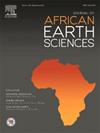Organic geochemistry and hydrocarbon generation characteristics of Cretaceous outcrop source rocks from the Nigerian Frontier basins
IF 2.2
4区 地球科学
Q2 GEOSCIENCES, MULTIDISCIPLINARY
引用次数: 0
Abstract
The present study integrates organic petrographic and geochemical analyses to determine and compare the nature of organic matter, maceral assemblages, paleodepositional environment, and hydrocarbon generation characteristics of Cretaceous aged outcrop grayish-dark mudstones (claystones and shales), coaly-shale, and coals from some parts of Anambra, Bida and Dahomey Basins. The total organic carbon (TOC) obtained in the studied coals (14.41–53.69 wt%) and mudstones/shales (0.62 and 14.58 wt%) indicate excellent and a wide range (i.e., excellent – fair) of source rocks, respectively. Pyrolysis S2 of the coals revealed excellent source rock generative potentials, while average pyrolysis S2 of the mudstones/shales, (Anambra: 4.04, Bida: 4.43, and Dahomey: 25.86) indicate a wide range of source rock potentials from good-poor, excellent-poor and very good, respectively. The cross plots of HI vs Tmax, and HI vs OI in addition to maceral assemblages indicate types II, II/III, and III organic matter in the Anambra Basin, types II/III and III-IV in the Bida and type II/III in the Dahomey Basin. Vitrinite/huminite reflectance (Ro), in addition to Tmax, and other biomarker maturity parameters indicate immature thermal conditions before the onset of hydrocarbon generation in all the studied samples. The general low reflectance in the samples could be a result of perhydrous in the coals or due to marine influence. Further, similarities in the maceral assemblages in the studied samples suggest that the mudstones/shales were deposited in proximity to the coal beds. The macerals as identified through transmitted and reflected lights indicate that vitrinites/huminites are dominant with liptinites also having significant proportions (liptinite: Anambra: ≤40 %, Bida: ≤23 %, Dahomey: ≤37 %). The high proportions of liptinites (40-23 %) in addition to high hydrogen indices (HI) (>200 mg HC/g TOC) in the studied coals indicate that they could generate liquid hydrocarbons upon attaining appropriate thermal maturity level. Based on vitrinite reflectance values, the coals fall into lignite to sub-bituminous coal ranks. However, despite the low thermal maturity level in source rock from the Dahomey Basin, occurrence of exsudatinite in the sample indicates in-situ generation of petroleum-like substance. Resin-derived biomarkers (i.e., cadalene and retene) in the Dahomey source rock suggest that resinite macerals could be the source of the in-situ generated petroleum-like substance. The findings in the present study will help in making appropriate decisions on further hydrocarbon exploration activities in the Nigerian Frontier Basins and will serve as pointer to where hydrocarbons could be explored for in the basins.
尼日利亚边境盆地白垩系露头烃源岩有机地球化学及生烃特征
本研究结合有机岩石学和地球化学分析,确定并比较了阿南布拉盆地、比达盆地和达荷美盆地部分地区白垩系出露灰黑色泥岩(粘土岩和页岩)、煤-页岩和煤的有机质性质、显微组分组合、古沉积环境和生烃特征。煤总有机碳(TOC) (14.41 ~ 53.69 wt%)和泥岩/页岩总有机碳(TOC) (0.62 wt%和14.58 wt%)分别表明烃源岩为优良烃源岩和范围较广的烃源岩。煤的热解S2表现出良好的烃源岩生烃潜力,而泥岩/页岩的平均热解S2 (Anambra: 4.04, Bida: 4.43, Dahomey: 25.86)分别表现为好-差、优-差和极好烃源岩生烃潜力。除组分组合外,HI - Tmax、HI - OI交叉图显示阿南布拉盆地为II、II/III和III型有机质,比达盆地为II/III和III- iv型有机质,达荷美盆地为II/III型有机质。镜质组/腐殖组反射率(Ro)、Tmax和其他生物标志物成熟度参数表明,在所有研究样品中,在生烃开始之前,热环境还不成熟。样品中普遍的低反射率可能是煤中的过水或海洋影响的结果。此外,研究样品中显微组分组合的相似性表明,泥岩/页岩沉积在煤层附近。通过透射光和反射光的显微组分鉴定表明,镜质组/腐质组为主,岩石质组也有相当比例(岩石质组:Anambra≤40%,Bida≤23%,Dahomey≤37%)。煤中脂质岩比例高(40 ~ 23%),氢指数高(约200 mg HC/g TOC),表明煤在达到适当的热成熟水平后可生成液态烃。镜质体反射率值表明,煤属褐煤至亚烟煤级。然而,尽管达荷美盆地烃源岩的热成熟度水平较低,但样品中存在辉长岩,表明在原位生成了类石油物质。达荷美烃源岩中的树脂类生物标志物(即钙二烯和泥质)表明,树脂类矿物可能是原位生成的类石油物质的来源。本研究的结果将有助于对尼日利亚边境盆地的进一步油气勘探活动做出适当的决定,并将作为盆地中油气勘探的指针。
本文章由计算机程序翻译,如有差异,请以英文原文为准。
求助全文
约1分钟内获得全文
求助全文
来源期刊

Journal of African Earth Sciences
地学-地球科学综合
CiteScore
4.70
自引率
4.30%
发文量
240
审稿时长
12 months
期刊介绍:
The Journal of African Earth Sciences sees itself as the prime geological journal for all aspects of the Earth Sciences about the African plate. Papers dealing with peripheral areas are welcome if they demonstrate a tight link with Africa.
The Journal publishes high quality, peer-reviewed scientific papers. It is devoted primarily to research papers but short communications relating to new developments of broad interest, reviews and book reviews will also be considered. Papers must have international appeal and should present work of more regional than local significance and dealing with well identified and justified scientific questions. Specialised technical papers, analytical or exploration reports must be avoided. Papers on applied geology should preferably be linked to such core disciplines and must be addressed to a more general geoscientific audience.
 求助内容:
求助内容: 应助结果提醒方式:
应助结果提醒方式:


